Moist, airy, and light, Japanese Strawberry Shortcake is among the most popular cakes in Japan. This elegant and classic dessert is perfect for any celebration. Here, I share how to keep the sponge cake moist and decorate it with berries and fresh whipped cream.
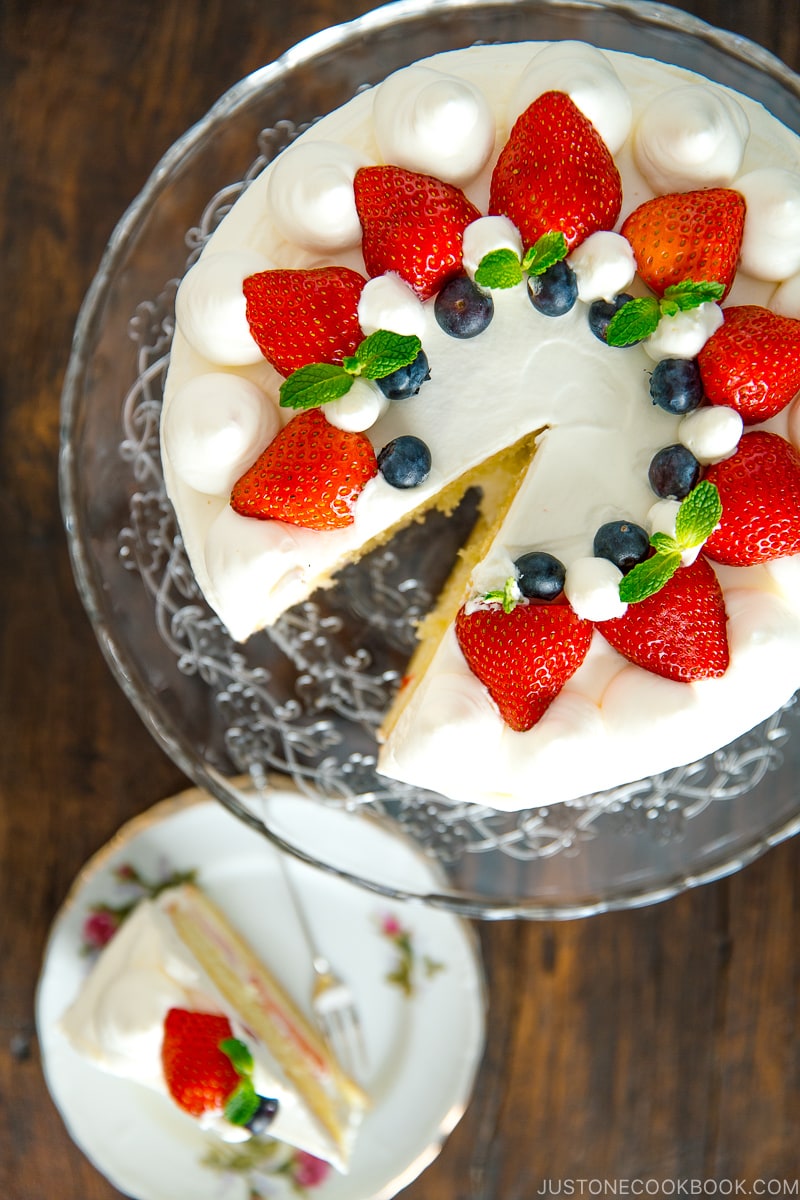
Strawberry Shortcake is probably one of the most popular and classic cakes in Japan. Whether it’s for birthdays, Christmas (did you know this cake is also sold as “Christmas Cake”?) or any type of celebration, we enjoy Strawberry Shortcake all year round. Cakes have such a special place in Japanese culture that we even bring them when we visit friends and family.
If you need a classy dessert to serve at your dinner party or something special for a bridal shower, a beautiful homemade Japanese Strawberry Cake fits the bill for the most special occasions. With some basics from the pantry, this simple yet elegant cake is one to remember when celebration season hits. Or when the strawberry is in season in your area, you have good enough reason to whip up this sweet treat to celebrate. I promise, your guests will fall hard for it!
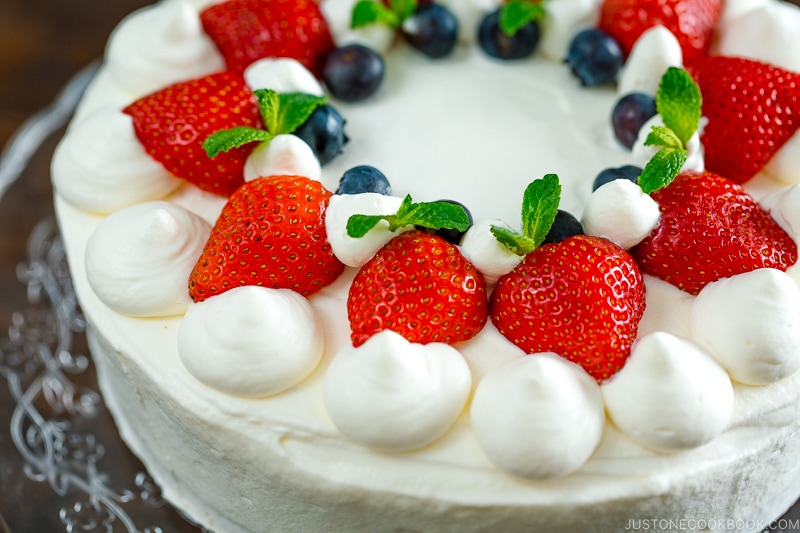
What is the Japanese Strawberry Shortcake?
The concept of the Japanese Strawberry Shortcake may have originated in the US with some adaptation. Instead of sweet biscuits, a Japanese strawberry shortcake is made of 2-3 layers of sponge cake, with fresh strawberry slices, whipped cream filling, and whipped cream frosting.
This cake might seem rather simple, yet when all the components are prepared perfectly, it comes together as an amazing dessert.
The majority of recipes for Japanese strawberry shortcakes are very similar, so what makes them different? It all comes down to the various techniques you use when making it. I want to thank my dear friend Naomi for spending hours in my kitchen testing different variations of strawberry shortcake recipes with me. We spent days testing and making so many cakes, and we decided this is by far the best one.
Because this recipe requires detailed explanations, it was impossible for Mr. JOC to take step-by-step pictures AND film the video at the same time. Therefore, we decided to focus on the step-by-step pictures this time because I can’t explain everything in our short video. We’ll add a video for this recipe in the future.

Components of Japanese Strawberry Shortcake
This recipe is probably one of the longest recipes on my blog, with close to 50 steps. I know it’s a bit of an overkill but I really think these step-by-step pictures are helpful and I can explain the step a little more in detail along the way.
Japanese strawberry shortcake consists of 3 components: sponge cake, whipped cream, and strawberries. It’s simple as that. However, creating the perfect sponge cake and whipped cream involves many techniques.
And to make a really good shortcake, precise measurement (please use a kitchen scale and thermometer!) really helps, especially if you don’t bake often.
Sponge Cake
Japanese sponge cake is very moist, airy, light, and it’s not overly sweet. Personally, I think this is the most important part of the cake.
The sponge cake is a genoise cake. It‘s made by beating air into the eggs to make it rise. This replaces a chemical leavening agent like baking soda or baking powder.
The dimensions of the sponge cake we need to consider include sweetness, elasticity, and texture.
The sponge cake cannot be too sweet or else it overpowers the whipped cream and the tartness of the strawberry. The sweetness has to be perfectly balanced with the rest of the cake.
When you bite into the sponge cake, it needs to have some elasticity and firmness of bite. Once again, if it’s too hard or too soft, it ruins the cake.
Lastly and probably the most critical is the texture of the sponge cake. The size of the bubbles within the sponge needs to be consistent. It should not be too rough on the tongue yet it does need some structure so you can feel them. This is probably the part I tested the most to achieve the perfect result.
By the way, if you want to bake a flat cake (my cake is a little curve on the top), I found a great article to solve this problem!
Freshly Whipped Cream
To make fresh whipped cream is not too difficult. Before you begin whipping cream, make sure to chill your bowl and the heavy cream. This allows the cream to stay cold longer during the whipping process. Basically, cream whips better when it’s cold. The temperature affects how long it requires to whip, how light and fluffy it will get, and how long it is likely to stay that way (more science here).
My friend and I have tested the different amounts of sugar and we concluded that 8% of sugar to heavy whipping cream ratio gives perfect sweetness for the cake.
Fresh Strawberries
Fresh strawberries might not be the easiest ingredient to purchase depends on where you live. I know I’m spoiled in California where we literally have strawberries all year round. When you select the strawberries, make sure they are equal in size and not too large so they’ll be more visually appealing.
Last note, since we do not wash the strawberries but clean them with a damp cloth (to prevent them from going bad and adding moisture to the cream.), I do recommend buying organic ones.
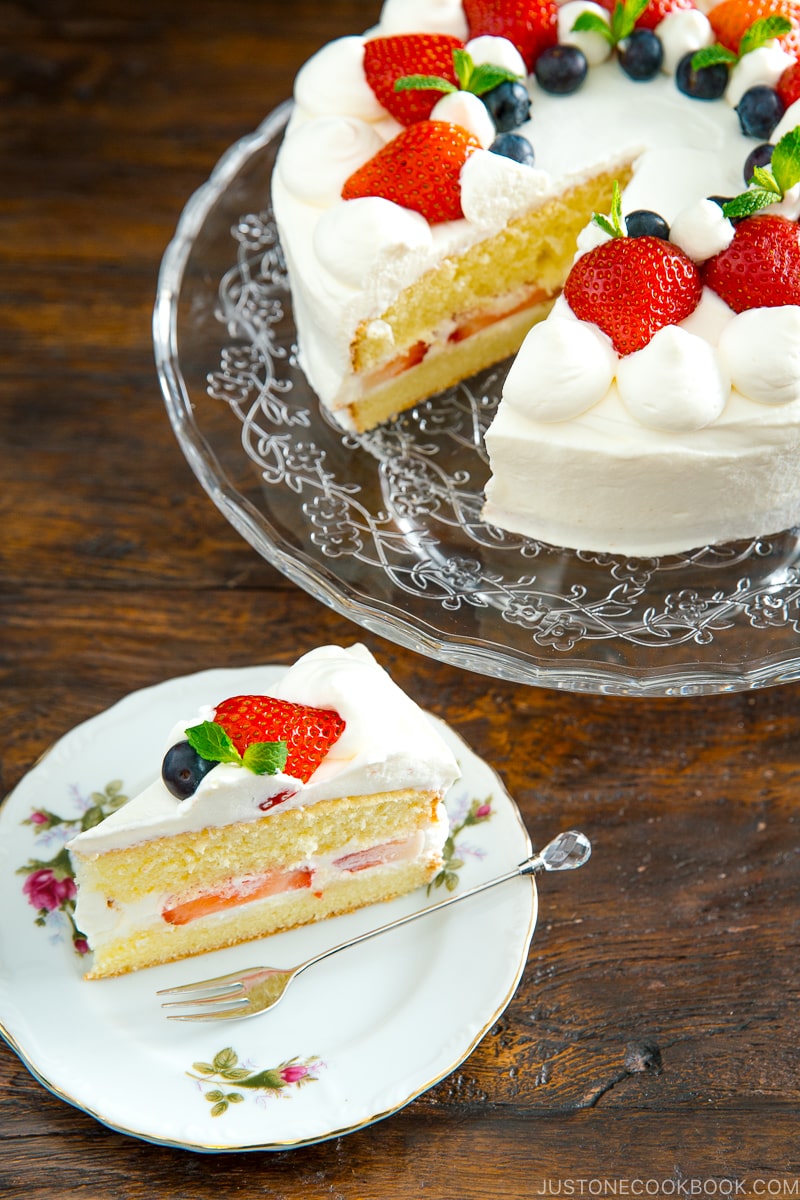
Japanese Strawberry Shortcake for the Holidays
After several recipe testings, I am really happy with my results. My friends and family who enjoyed the cake agreed as well. Since then, I’ve served the Japanese strawberry shortcake several times over the holidays and it’s been a huge hit.
The flavor and texture of strawberry shortcake get even better if you let it rest overnight, so it is also a great make-ahead treat.
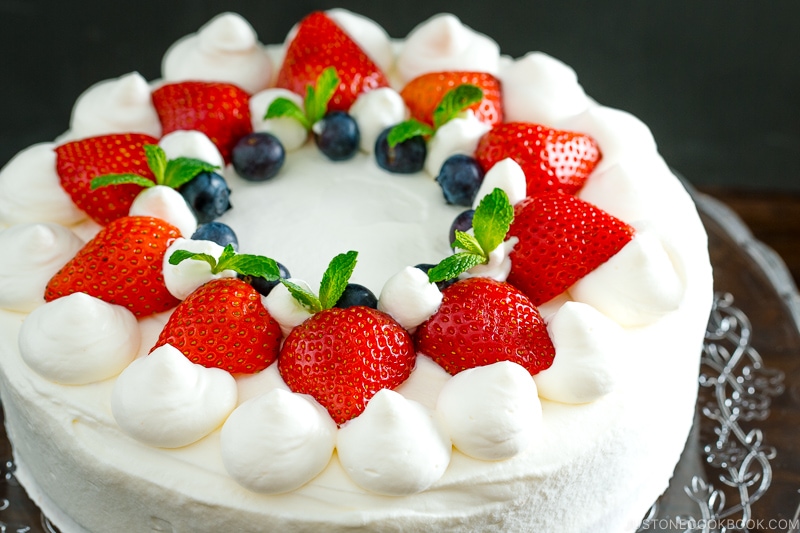
Wish to learn more about Japanese cooking? Sign up for our free newsletter to receive cooking tips & recipe updates! And stay in touch with me on Facebook, Pinterest, YouTube, and Instagram.
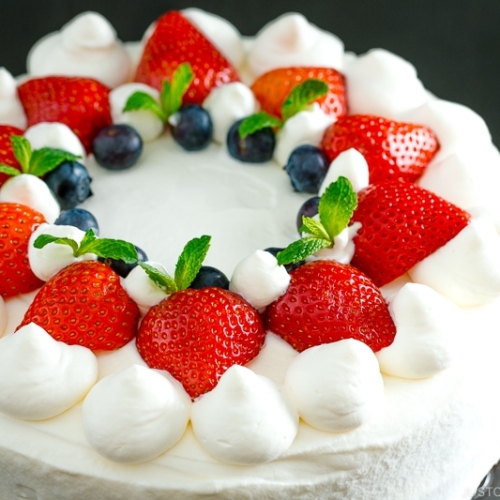
Japanese Strawberry Shortcake
Ingredients
- 1 Tbsp butter (for greasing the pan; or use shortening or cooking spray)
For the Sponge Cake
- 3 Tbsp unsalted butter
- 2 Tbsp whole milk (use whole milk for the best results)
- 4 large eggs (50 g each w/o shell)
- ½ cup sugar (½ cup + 2 Tbsp, to be precise)
- 1 cup cake flour (weigh your flour or use the “fluff and sprinkle“ method and level it off; see Notes for how to make your own cake flour)
For the Syrup
- 2 Tbsp water
- 3 Tbsp sugar
- 1 Tbsp liquor of your choice (optional; I like orange liqueurs like Grand Marnier or Cointreau)
For the Fresh Whipped Cream
- 2 cups heavy (whipping) cream (36% fat; must be at least 30–35% fat)
- 3 Tbsp sugar
For the Decoration
- 1 lb strawberries (for filling and decoration; look for similar-sized strawberries to decorate the cake; buy an extra pack to increase your chances of finding berries of the same size)
- 10 blueberries
- 2 sprigs mint leaves
Instructions
Before You Start…
- Gather all the ingredients. I highly encourage you to weigh your ingredients using a kitchen scale for this recipe. Click on the “Metric“ button at the top of the recipe to convert the ingredient measurements to metric. If you‘re using a cup measurement, please follow the “fluff and sprinkle“ method: Fluff your flour with a spoon, sprinkle the flour into your measuring cup, and level it off. Otherwise, you may scoop more flour than you need.

- Make sure the eggs and butter are at room temperature. Sift the cake flour at least twice.

To Prepare the Pan, Oven, and Double Boiler
- Place an 8-inch (20-cm) cake pan on top of parchment paper, trace around the pan, and cut out 1 circle. Grease one side of the parchment paper and both the bottom and sides of 1 cake pan with 1 Tbsp butter. Then fit the parchment paper in the cake pan, greased side up. I avoid parchment paper on the sides because sometimes it pulls the batter and affects the final result of the cake.

- Preheat your oven to 350ºF (180ºC). For a convection oven, reduce cooking temperature by 25ºF (15ºC). It’s always better to preheat longer, preferably 15–20 minutes extra. Tip: You preheat the oven so that all the surfaces inside your oven (walls, floor, door, and racks) are the desired cooking temperature. This makes for an even temperature throughout the oven and you won’t lose as much heat when you open the door for a few seconds. Depending on your oven, preheating might take 10 to 20 minutes.

- Prepare a double boiler. If you have never done this before, please see the Notes section below. Turn on the stove’s heat to high and bring the water in the saucepan (Pot A) to a rapid boil. Once boiling, reduce the heat to maintain a steady simmer. Put 3 Tbsp unsalted butter in the small bowl (Bowl #1) and set over the saucepan. Let the butter melt gently.

- Once the butter is melted, remove the bowl from the saucepan. Then add 2 Tbsp whole milk and whisk to combine. Set aside to keep it around 104ºF (40ºC). Tip: I highly recommend using whole milk instead of reduced-fat milk. I’ve tried using both and concluded that whole-fat milk makes a difference in the final result.

To Make the Sponge Cake (can make a day ahead)
- In a stand mixer bowl (Bowl #2), add 4 large eggs (50 g each w/o shell) and break the egg yolks and whites with your whisk.

- Add ½ cup sugar (½ cup + 2 Tbsp, to be precise) and whisk to combine.

- In a large pot (Pot B), bring about 2 inches of water to 140ºF (60ºC) and maintain the temperature. Then, set the stand mixer bowl (Bowl #2) directly over the pot and whisk constantly so the eggs don’t scramble. This is called a bain-marie or water bath, where you set the bowl of food directly over a larger container of simmering water to temper the heat for gentle, even cooking. You can also use the double boiler method, where you set the egg mixture bowl (Bowl #2) over Pot B. The bowl doesn’t touch the simmering water of the pot.

- Whisk until the temperature of the egg mixture reaches 104ºF (40ºC). Remove Bowl #2 from Pot B and set it up on the stand mixer with the whisk attachment.

- Whisk on high speed (Speed 10) until the mixture is fluffy, for about 2 minutes. The batter should be loose yet thick and glossy.

- When the batter is pale, fluffy, and tripled in volume, reduce the speed to low (Speed 4) for several seconds. Stop the mixer and lift some of the batter with the whisk to check the consistency. If the batter falls off your whisk in a solid line or ribbon on top of the mixture, you’ve reached the “ribbon stage” (see Notes). Remove the bowl from the stand mixer.

- Add half of the 1 cup cake flour to the bowl. Using the whisk, fold gently but thoroughly. Do this by rotating your bowl slowly while simultaneously moving your whisk in a down-and-over motion.

- Add the rest of the flour and fold gently to make sure all the flour is incorporated quickly so your mixture doesn’t deflate.

- With your spatula, take out one scoop of the batter from the bowl and add it to the butter and milk mixture. Tip: If we add the butter and milk mixture into the entire cake batter, the fat in the butter will deflate the batter.

- Incorporate the butter and milk mixture into a small amount of the batter first before adding it to the entire cake batter.

- Add the mixture back into the cake batter by pouring it over a silicone spatula. This prevents the mixture from deflating the batter and helps disperse the mixture. Gently fold until incorporated. When you lift the spatula, the batter should fall like a ribbon.

- Pour the batter into the center of the cake pan, from right above the cake pan. You want to avoid introducing extra air into the batter at this point. Collect the leftover batter in the bowl and pour it around the edges of the cake pan, not the center.

- Firmly tap the cake pan on the counter to release air bubbles in the batter.

To Bake
- In the preheated oven, bake at 350ºF (180ºC) for 20–25 minutes. Check if the sponge cake is done by inserting a skewer in the middle; if it comes out clean, the cake is ready. While the cake is baking, start preparations for the cake assembly (see below).

- As soon as you take out the cake pan from the oven, drop it on the counter to “shock” the cake so it stops shrinking. Separate the cake from the pan by running a sharp knife or offset spatula around the sides.

- Take the cake out of the pan by placing the wire rack on top and flipping the cake over onto the rack.

- Immediately remove the parchment paper.

- Place another wire rack on top and flip it back over. The top of the cake is now facing up.

- Cover the cake with a damp towel until cooled to keep moisture in the cake. Make sure the towel is thin (not heavy) and wring the water out well so that the towel is damp, not wet. I use IKEA’s thin dish towel. If you keep the sponge cake for later use, wrap it with plastic wrap after it‘s completely cooled and keep it in the fridge (see Notes). Tip: You can make the sponge cake the day before. It actually tastes better and it's easier to slice the cake in half.

To Prepare the Strawberries and Syrup (While the Cake is Baking)
- While the cake is baking, divide 1 lb strawberries into 2 groups, one for the decoration and the other for the filling. Keep the beautiful, same-sized strawberries for the decoration. Remove the husk and clean the strawberries with a damp paper towel (do not wash, as we don’t want the strawberries to be moist and become moldy). Slice off the core for all the strawberries.

- For the strawberries that we will use for the decoration, cut them in half lengthwise. For the strawberries that we will use for filling, slice them lengthwise into ¼-inch (5 mm) slices.

- To make the syrup, combine 2 Tbsp water, 3 Tbsp sugar, and 1 Tbsp liquor of your choice (optional) in a small bowl (Bowl #3). Microwave for 1 minute to dissolve the sugar.

To Make the Fresh Whipped Cream (While the Cake is Cooling)
- While the cake is cooling, prepare an ice bath by placing ice cubes and water in a large bowl (Bowl #4). Place a clean and dry mixing bowl (Bowl #2) in the ice bath and add 2 cups heavy (whipping) cream and 3 Tbsp sugar to keep it cold. Tip: For the perfect sweetness, the sugar should be 8% of the heavy cream weight.

- Transfer the mixing bowl to the stand mixer and whisk on high speed. The cream will become thicker and smooth. When you lift the whisk out of the cream while it’s still liquid, and the cream holds its shape as it drops, it’s ready. Remove the bowl from the stand mixer and put it back in the ice bath.

To Assemble the Cake
- With a serrated knife, slice the cooled cake horizontally into half to make 2 layers (top and bottom).

- Place the bottom of the cake on the cake circle. Brush the syrup on the top and sides of the bottom layer. This will help the sponge cake stay moist.

- Using a hand whisk, whisk only the cream at one spot by the edge of the bowl instead of whisking the entire bowl of cream. We will make the whipped cream as we need it. With this approach, we can also control the stiffness of the whipped cream.

- When the cream at the edge of the bowl reaches medium peaks, transfer it to the top of the bottom cake layer. Medium peaks mean when you lift the whisk, the cream will hold its shape, but the tip of the peaks will fold back on itself.

- Spread the whipped cream evenly. If you don’t have enough whipped cream, whip more and add it onto the cake.

- Place the sliced strawberries on top of the whipped cream as you see in the pictures. Keep the center area open by not covering it with strawberries. This will make it easier to cut the cake into slices.

- Whip the cream again at the edge of the bowl.

- Transfer the whipped cream to the top of the strawberry layer. Spread just enough cream to cover the strawberries; do not add too much.

- Place the top layer of the sponge cake over the bottom layer. Brush the syrup on the top and sides of the sponge cake.

- Whip more cream and place it on top of the cake.

- Place the tip of the offset spatula in the center of the cake at a 30-degree angle and turn the cake turntable toward you to create a smooth top. Lightly coat the sides of the cake with a thin layer of whipped cream.

- Now add more cream to the sides, little by little. Place the offset spatula at a 90-degree angle and push the turntable away from you.

- Remove the excess cream from the cake and put it back into the bowl.

To Decorate the Cake
- For a basic decoration, I use a Wilton 2A decorating tip. Put the tip in the piping bag and cut off the tip so the metal will show from the bag. Fold the top half of the bag outward as you see in the picture (over your hands).

- Whip the cream to stiff peaks. When you lift the whisk, the peaks will hold firm. Put the cream into the piping bag. Once you fill the bag halfway, lift up the top half of the bag and push the cream down toward the tip.

- Squeeze the piping bag to test to make sure the cream comes out smoothly. When you’re ready, hold the piping bag at a 90-degree angle and squeeze about a 1-inch-wide ring of whipped cream around the top edge of the cake. This will be the base for the strawberries.

- Decorate and place the strawberries cut-side down on top of the whipped cream. Then squeeze small dollops of whipped cream between and around all the strawberries. Place 10 blueberries between the whipped cream dollops. Place 2 sprigs mint leaves as desired to add color.

To Store
- I recommend putting the cake on a cake stand with a dome or in a cake box to keep the cake shape while preventing it from drying. Keep the cake in the refrigerator and enjoy it within 2 days.
Notes
- For 1 cup cake flour, measure 1 cup all-purpose flour, then take away 2 Tbsp all-purpose flour and add 2 Tbsp cornstarch. Be sure to sift the flour to distribute the cornstarch well before using it in your cake batter.
- small heat-resistant bowl (Bowl #1)
- small saucepan that fits Bowl #1 for the double boiler (Pot A)
- stand mixer bowl or large mixing bowl (Bowl #2)
- large pot that fits Bowl #2 for the bain-marie (Pot B)
- small bowl (Bowl #3)
- large bowl that fits Bowl #2 for the ice bath (Bowl #4)
- parchment paper
- cake pan (8 inches/20 cm)
- balloon whisk
- silicone spatula
- 2 wire racks
- offset spatula
- cake decorating tip Wilton 2A and plastic bag
- thermometer
- serrated knife
- cake circle (10″/25 cm)
- cake turntable
- cake stand with dome or cake box
Nutrition
Editor’s Note: The post was originally published on December 14, 2015
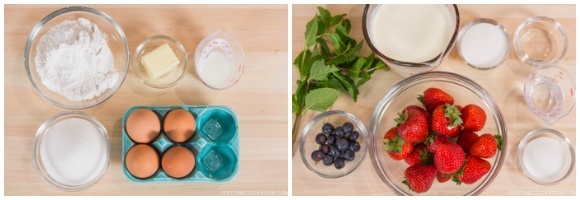
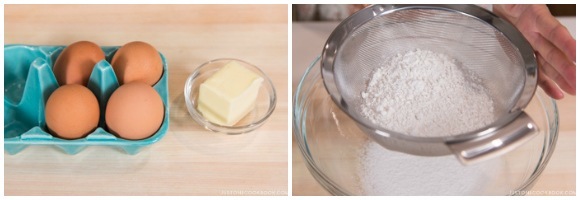
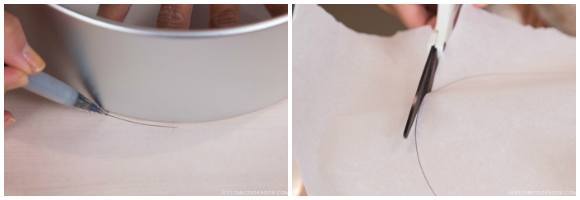
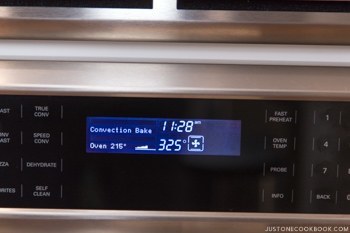
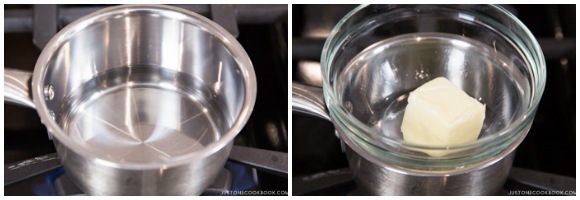
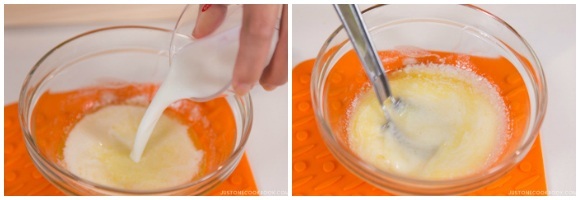
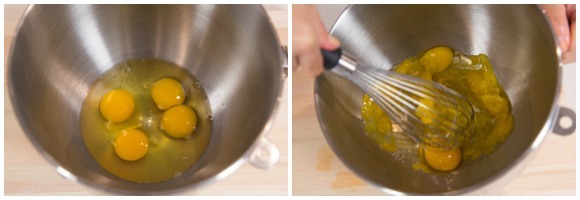

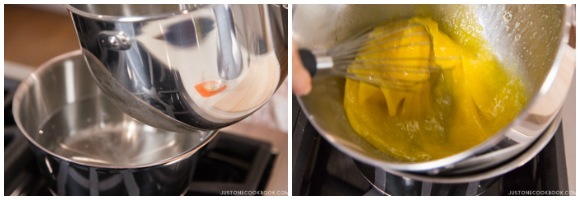
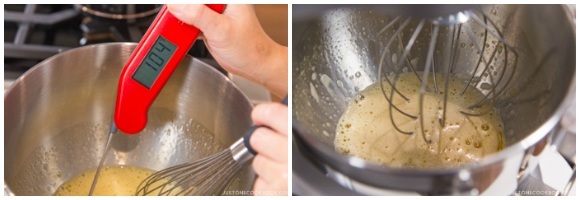
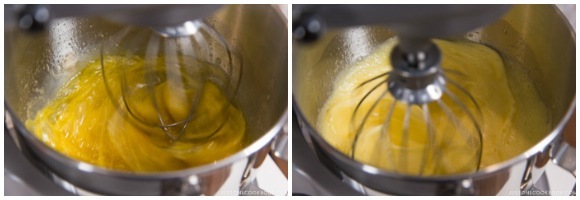
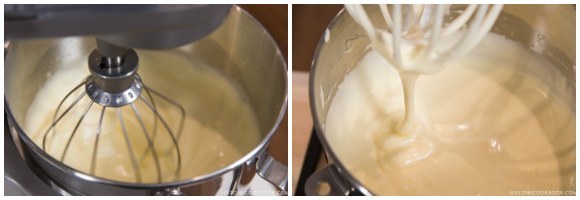
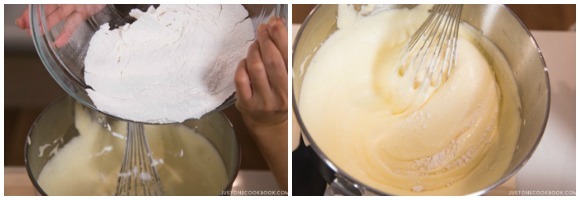
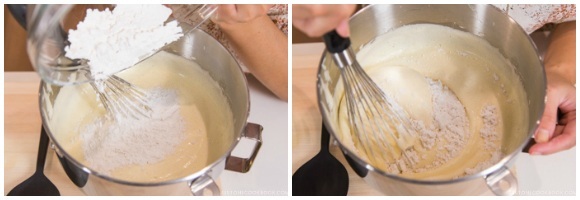
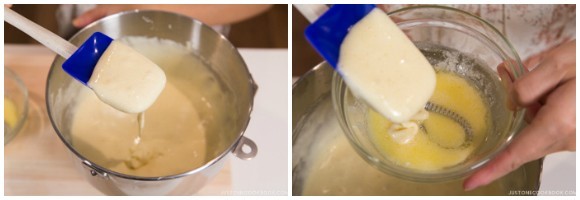
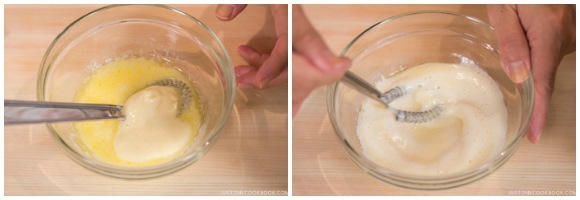
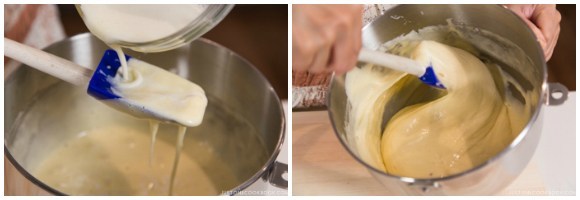
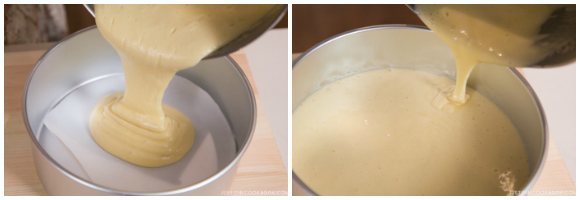
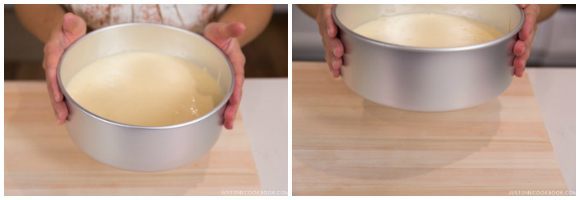
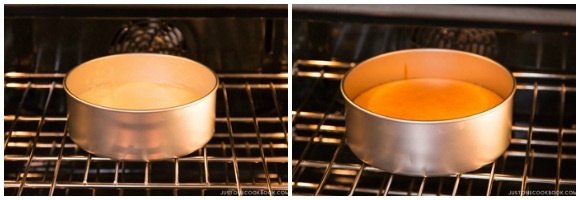
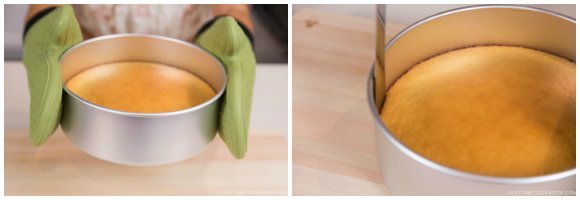
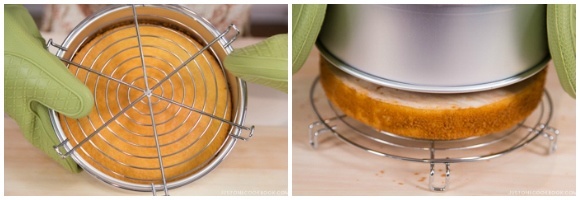
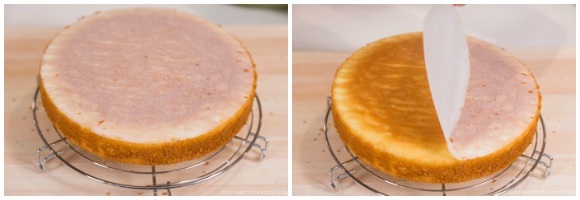
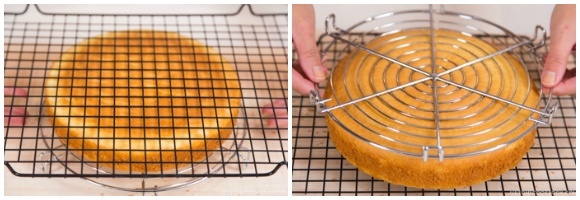
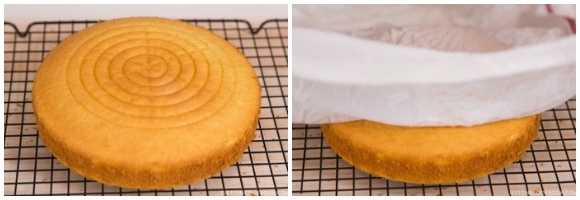
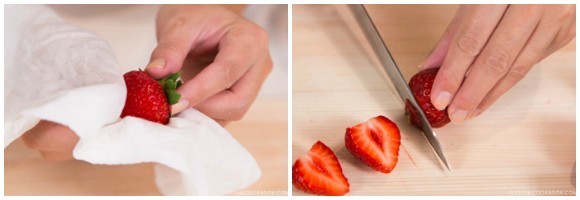
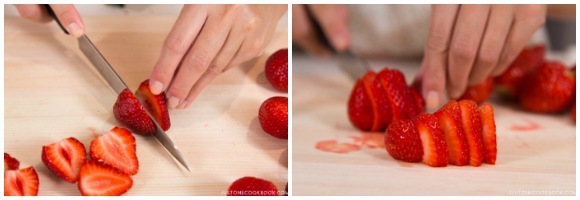
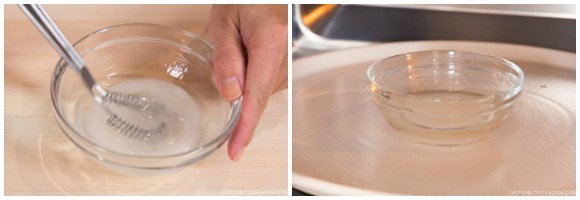
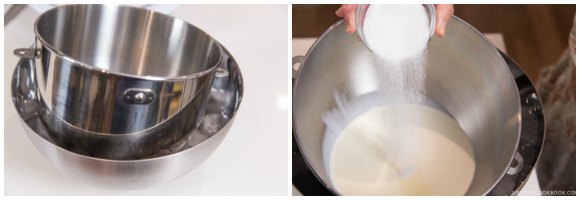
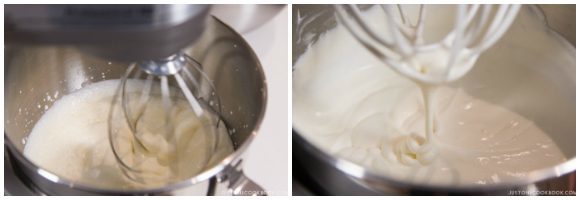
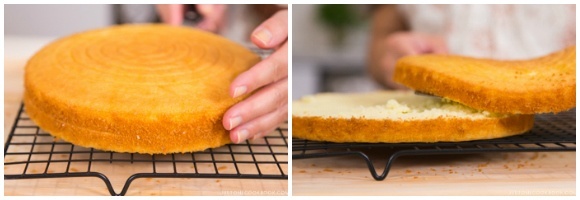
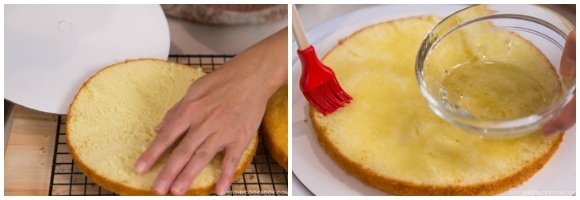
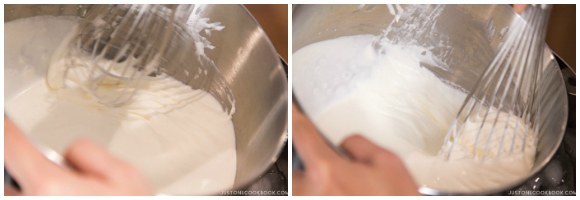
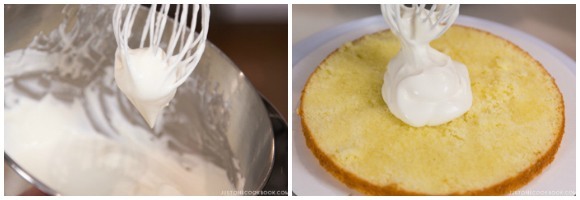
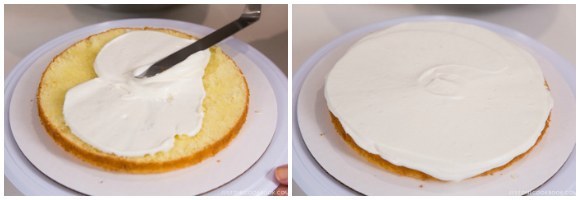
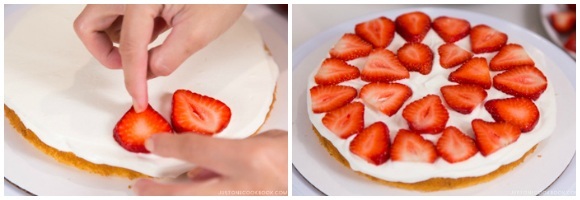
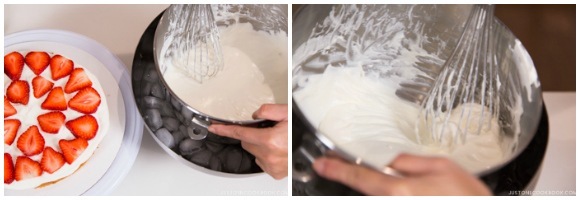
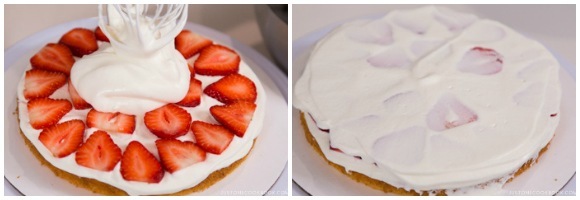
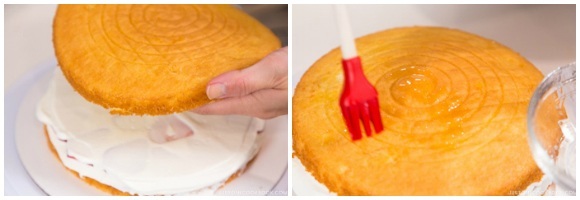
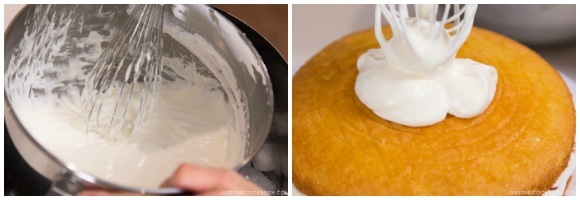
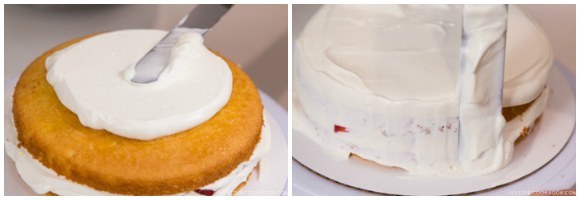
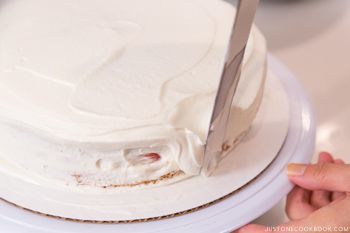
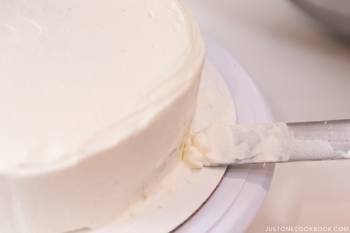
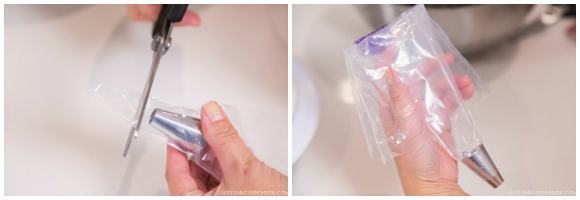
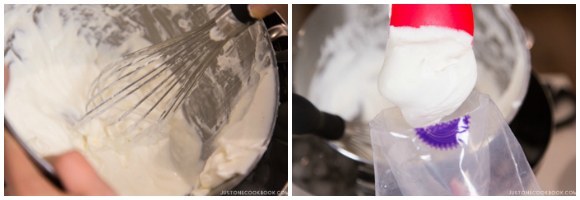
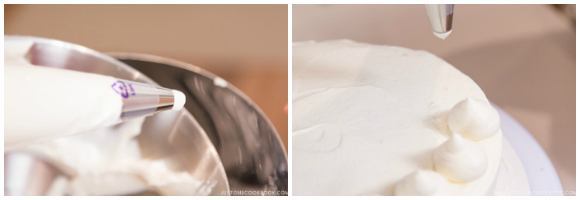
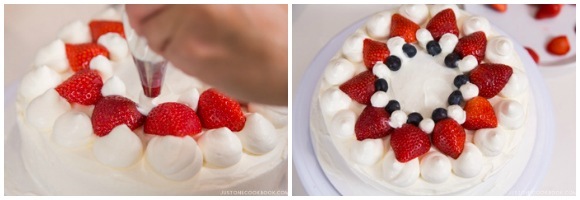
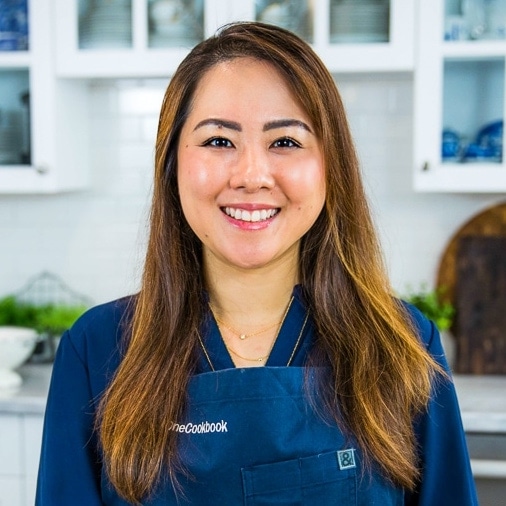
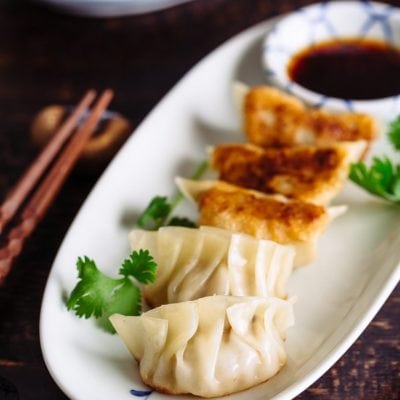
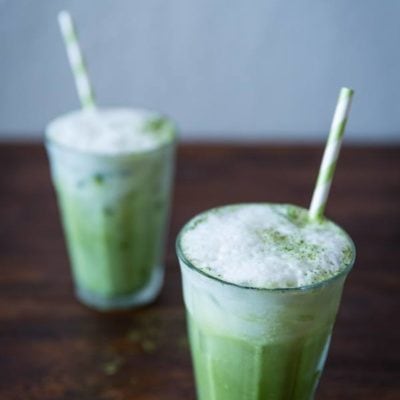
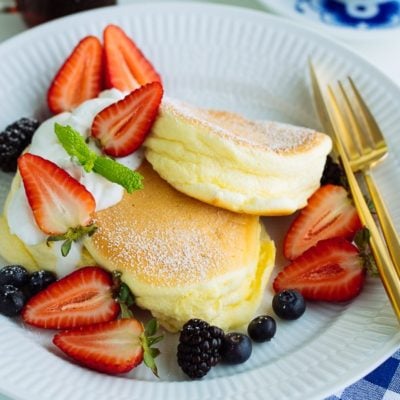
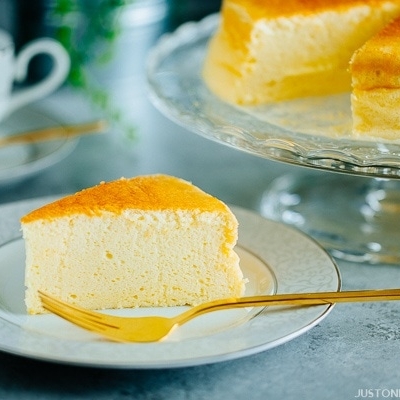
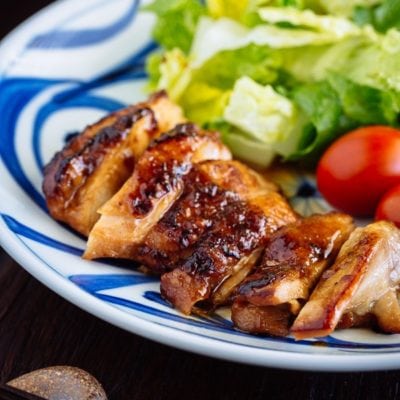
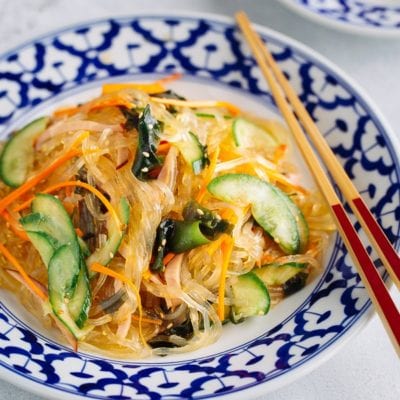
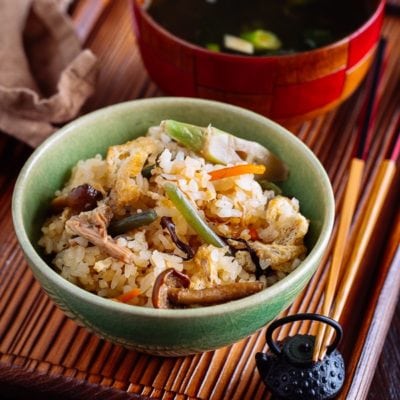
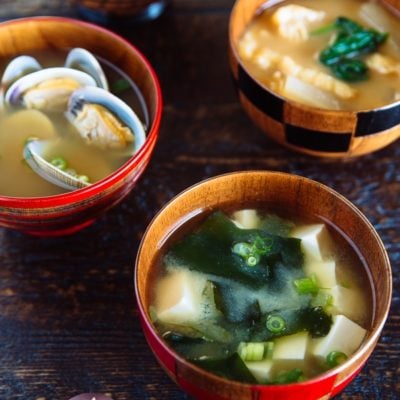


The cake looks beautiful! It looks just like it came from a japanese bakery. I wanted to make this recipe but is it okay to use 2 regular 9inch cake pan. That’s all I have and I wouldn’t want to overflow the batter by putting it all in one pan. Sorry if it’s a silly question but I’m not much of a baker.
Hi Quynh-Anh! I haven’t tried with 2 9-inch cake pan, but sure. That way the sponge cake is flatter and you use 2 cakes to stuck up one on the other. I hope you enjoy this recipe! 🙂
This is our favorite cake! so happy that You posted this recipe. But, my oh my, look so hard lol. Iam not a baker, but will try someday!
Thanks Nami. Aloha!
Hi Yulie! I hope you enjoy making this cake! I am not a baker (or I wouldn’t call myself a baker), so that’s why I tried to write a detailed explanation for each step. I know how hard it is to have one sentence of explanation when a beginner baker try to bake. 🙂 So don’t let many steps intimidate you, it’s actually for the beginners. 🙂
Wow. Looks absolutely fantastic! I was waiting for this recipe for years and it finally came! I’m looking forward to baking this one! 🙂 Thanks for the recipe!
Hi Megumi! Thanks so much for waiting! I hope you enjoy this recipe!
Thanks! I was wondering if you were considering about making a video for this recipe as well… (?)
Hi Megumi! Yes, I plan to shoot a video one day as we couldn’t fit in our shooting schedule this year. I know it’ll be very helpful to see it visually. 🙂
Thanks! I’m looking forward to it! 🙂 🙂
Hello Nami,
Another amazing recipe I tried from you! My family love every dish that i cook with your recipes! Thank you so much! Just a quick question for this recipe, what’s the purpose behind warming the eggs a little on a double bath before putting it to the mixer? Thanks for explaining!
Hi Natalie! Thank you so much for your kind feedback. I’m glad to hear your family enjoyed my recipes too. 🙂 We refer to this method as Tomodate ( “Genoise method in Japan (https://en.wikipedia.org/wiki/Genoise). It creates a moist and finer texture. Maybe you can translate this article to see the difference? https://www.cotta.jp/special/article/?p=541
Hi!
My brother just linked me this recipe, saying that “If you want to bake so badly, then do this!” His birthday’s next week, but unfortunately I can’t get any of these fruits at winter where I live. Are there any alternatives maybe? I really would love to surprise him.
Cheers
Hi Lea! If no fresh fruits, you can try with canned peach, maybe. 🙂 Happy Birthday to your brother!
Yet again another wonderful recipe that you have shared with us. Thank you once again. And the extra details are appreciated.
And yes, you really should rest your body more than 4-5 hours a day. I’m sure people will understand if you spent a few hours less keeping in touch with them. You must above all take care of yourself first.
Hi Jerry! Thank you! I know, I need more discipline. I get too excited when it comes to working on a to do list… and I have this urge to cross out the check out list. =P I’ll do better job! Thank you for caring about me. 🙂
Your welcome, Nami. I do look forward to see your videos of your wonderful recipes, so please don’t overwork yourself.
This cake looks so beautiful!! Do you think one batch of cake will be enough batter for two 6 inch cake pans?? Thank you!
Hi Jackie,
This recipe is for one 8 inches (20 cm) cake, but feel free to adjust the amount for two 6 inch cake pans!🙂
The cake looks like heaven. Can’t wait to tryit.
Thank you Theresa! Hope you enjoy! 🙂
What a gorgeous cake!! Thank you so much for the effort that went into perfecting and teaching us this recipe. Especially with baking, I think that the more details in the recipe certainly help. I like the trick you mentioned with helping the cake from shrinking; I’ll keep that in mind with other baking projects too. I suspect that you and your family are just about ready for the holidays!
Thank you Kimmi! I took notes in details while I baked this recipe many times, so hopefully they are helpful…. but I am not sure if my English was good enough to explain in details (or I might have confused even more! LOL). 😀 Happy holidays to you and your family!
Hi, thanks for the great details on the step-to-step recipe.
I manage to make this cake, fluffy and soft, despite I don’t really bake and that’s my first sponge cake. I was delighted.
I tried making it again today but with slight reduced sugar (90g) cos my family prefer less sweet. The cake still turns out nice but denser and not as fluffy as the original recipe. I wonder if I might have over mixed during the adding of flour or undermixed the egg batter or even perhaps I shouldn’t reduce the sugar too much….
Hope u might read this and could share some advise
Hi Brosche! Thank you for trying my recipe! I know that baking is science and reducing sugar can cause volume and texture change. The sugar and cake flour should be equal as well, and the ratio for eggs is no longer the same. So I recommend not changing the working recipe, or if you need to change, you may need to adjust slowly and not drastically. 🙂 Hope this helps! 🙂
Hi Nami,
Thanks so much for sharing this! Quick question, if I don’t have food grade thermometer with me, what do you suggest I should do to measure the temperature of certain steps? Especially like the butter that should be maintained at a certain temperature. Any suggestion or estimates on how warm they should be like? Thank you!
Hi Laura! Hmm it’s a bit hard without thermometer for this method. 104F (40C) is like a bit warmer than human body temperature. 140F (60C) is hot but you can quickly touch.
https://www.jm.com/en/blog/2015/february/too-hot-to-handle/ (this kind of gives you some idea).
Thanks Nami for the reply! I decided to get a thermometer so hopefully I can make this a success hehe. Thanks again for sharing and replying! Will keep you posted 🙂
Hi Laura! I really believe having a thermometer in the kitchen is very important (and a scale!). 🙂 Good luck and please keep me posted. xo
50 steps is a long recipe but since I have never in all the years I have been trying to perfect strawberry shortcake, managed to bake a perfect one, I am so grateful for the detail!! If it works for me will post a pic!!
I shouldn’t have scared my readers with “50 steps”! LOL. It’s actually lots of baby steps that can be one step… I just wanted to be thorough, as if I was next to my reader when I explain. 😀 Hope this recipe will help… Good luck!
Hello!
Thanks so much for this amazing recipe, I am so excited to make it!!
Just wondering- is it possible to double the recipe without making any adjustments?
Thanks
Hi Essie! You can double the recipe. But if you’re pouring the batter into the same cake pan, you will need to cook for a longer time. 🙂
Thank you for an amazingly detailed recipe! My son is home from Japan for Christmas and has brought his Japanese girlfriend. She has been eager to try American foods, but I know she loves the beautiful and elegant cakes common to Japan, and has mentioned Strawberry Shortcake in particular, so I hope to try your recipe for our Christmas dinner dessert. I hope I can find ripe berries where we live – it won’t be easy!
Hi Susan! How exciting that your son is back with his Japanese girlfriend! I remember my first time trying American foods (I was homestaying in Berkeley, lots of choices!). 🙂
She’ll be surprised to see Japanese strawberry shortcake at the dinner table! 🙂 Hope everyone will enjoy it!
p.s. I know, strawberries are hard to find this season, right? We still have really good strawberries here in California… Very sweet ones from farmers market…
So excited to make this! I’m thinking of making this before school starts agaiN!
Hi Khadijah! Good luck!!! Hope you enjoy this cake! 🙂
Looks fantastic! What a great tutorial. In Los Angeles, Phoenix bakery is well known for its strawberry cake (it is my family’s favorite) but I never knew it was a Japanese tradition.
Hi Julie! I should check out Phoenix Bakery… I’ll be down in LA this week! Yes, Japanese strawberry shortcake is pretty much the classic cake in Japan!
Yes, do! Its in Chinatown. Have a great trip”
I’m not much of a baker but I can’t wait to try to make this. It reminds me of my favorite cream cakes (they were usually more like slices) in the bakeries in Hong Kong when I was younger. Sadly they are almost impossible to find here in South Florida and have been getting hard to find even in Hong Kong.
Hi Cherry! I’m not much of a baker (you see my blog, not too many baked recipes compared to other food blogs. :)), so I tried my best to explain in details. I hope you give it a try! I think maybe this cake in square/rectangular in HK? Try not to make a perfect cake (I mean, “look” perfect). It will still taste delicious and you just have to practice with applying whipped cream to the cake… which for me was difficult part… especially to make it look pretty for the blog… haha.
Hi. I truly enjoy your recipes and reading the background info. It’s nice to have a better appreciation for the food we cook/eat.
I tried this recipe today and my cake turned out grainy. Does it mean that I haven’t mixed the flour in well enough? I was afraid of deflating the batter. If that’ the case, what can I do or how can I tell that flour has been mixed in well?
Hi Su! Thank you for your kind feedback. 🙂 It’s tricky, as you don’t want to deflate the batter but you have to incorporate the flour into the batter well. There should be no trace of flour but with a scooping (?) motion, it should be mixed from the bottom of the bowl.
This is a great time to make this cake! My family just went to Iceland for a week so I will have free time to make it before they come back! For the recipe, is it okay to eliminate the alcohol or does it taste better with it? Also hope you have a nice and happy holiday!
Hi Allison! Definitely! I was so worried I’m running behind in publishing this! I wanted to give some ample time for everyone so they can shop ingredients and tools for this recipe… and maybe some time enough time for practice….
Yes, you can skip alcohol, but make sure to apply syrup for extra flavor and moisture to the sponge cake. 🙂 Alcohol gives nice fragrance and flavor… I don’t drink alcohol (except for occasional wine), but I actually like adding liquor to syrup. Taste better! Happy holidays to you and your family!
p,s. I wish I could go to Iceland! That’s so cool!
Thank you thank you! I’m excited to make this. We always go to Fujiya in Japan and now we can enjoy at home.
Hi Mariko! Ohh you’re so lucky you can go to Fujiya! 🙂 Well, it’s always good to make homemade, so I hope you give it a try (at least once?). 🙂
Hi, very detailed explanation & I’ll try it soon. Can I ask if I need to add any stabilizer like pudding powder, etc to make whip cream last longer in hot climate? Thanks!
Hi Jerine! Thank you for your kind words. Unfortunately, I’ve never worked with a stabilizer before. I’m so sorry I wish I can give advice. 🙁
Thank you for putting in so much time and effort to explain the recipe. This really helps new and experienced bakers alike! Very thorough and clear. Thanks for sharing!
IMO, a short explanation with more steps is more helpful, especially in instances when I am not familiar with the recipe. It is like checking off a checklist as I go through the steps of the recipe.
Sometimes, reading a long paragraph can make me miss or skip some steps. Information overload! Haha…
Just my two cents… Hope it helps!
Thank you so much for your feedback, Jeanette! I feel the same way, and I’m glad you think so too! 🙂
Hi, Can i substitute the whole milk for plant milk?
Hi Deborah! I have never tried it but I hope that will work… 🙂
Hi
I have tried following all the steps given, but why my cake bottom is hard? What is the possible reason?
Hi Michelle, Thank you very much for trying this recipe!
It sounds like the bottom part is not cooked through. Possible reasons are;
1) The batter wasn’t combined well before pouring into the cake pan. Hence the heavy contents went to the bottom. The tip for beating eggs is to check the egg temperature, and the eggs will foam easily when at the right temperature, 104 ºF (40 ºC). Please make sure to reach the “ribbon stage.” And Mixing the cake batter with flour from the bottom of the bowl like you are drawing ”の” to incorporate more air in the batter is the best way.
2) Maybe your oven temperature is not optimal (it’s good to check/know your oven as each oven has hot spots, and sometimes the temperature is not accurate as the display says)
3) Maybe you didn’t measure the ingredients correctly (did you use a measuring cup or scale? If cup, We highly recommend the method Nami provided here (https://www.justonecookbook.com/faqs/#Measurements).
We hope one of these is the reason and your next try will be successful. 😊
I just made this for my son’s birthday and received rave reviews! everyone thought I bought it. Thank you so much for taking the time to explain the steps. i read it so many times but still missed steps. But it turned out OK. I reduced the sugar in the cake slightly and entirely omitted the sugar in the whipped cream (by mistake!) but everyone thought it was sweet enough. Thank u for this fab recipe. It doable and not so intimidating because of your explanations!
Hi Sue-Anne, Wonderful! We are so happy to hear the cake turned out perfect for your son’s birthday party!
Thank you very much for trying Nami’s recipe and for your kind feedback.
Can I use coconut sugar instead of normal white sugar? Are there any other substitutes for whipping cream (don’t like the taste of dairy and coconut cream)? Hope to hear from you asap, can’t wait to make this cake 🙂 Byw, love your website, I have tried so many of your recipes, so so good, my family love them. My kids want to move to Japan so they can eat Japanese food everyday
Hi Connie,
Thank you very much for your kind feedback. I’m so glad to hear you and your family enjoy many of Nami’s recipes!
This is a very classic cake in Japan and usually made with whipped cream filling, and whipped cream frosting. If you find good substitutes for whipping cream, please share with us!
As for sugar, we have never use the coconut sugar for this recipe before, so we are not sure how the outcome will be…. It may cause volume and texture change. If you try this recipe, please let us know how it goes!
I tried this recipe yesterday and I think I saw the sponge batter deflate when I added the 2nd round of flour. I don’t think I follow the steps on how to mix the flour properly. Also, I was a little confused by how to incorporate the butter milk mixture. Do you turn the whisk while you turn the bowl? Do you stir the milk butter flour mixture after pouring it in the batter via spatula? The sponge cake turned out pretty dense and not light and fluffy. However, I am cooking at high altitude. Do you think I need to make adjustments for that?
Hi Tammie! Thank you so much for trying this recipe.
Flour is heavy so sprinkle in and then fold the batter. You turn the bowl (for me, counterclockwise) with the left hand, while you use your right hand and fold the batter with scooping up motion from the bottom of the bowl (Step 7). Yes, at Step 11, I do fold in with a spatula.
Now the high altitude… I feel like this is the part that could be an issue. I do not know enough about high altitude baking, but I’ve heard adjustment is always necessary. I wish I have some experience but I have never baked in the environment. I’m sorry I can’t be helpful. 🙁
King Arthur Flour’s website has a great section on high altitude baking!
https://www.kingarthurflour.com/learn/resources/high-altitude-baking
I live at high altitude so I have to play with recipes. Will definitely try this one out thanks!
Hi Angela! Thank you so much for this helpful information!
An update. I made the forth cake batter. I changed all purpose flour to a gluten free flour (because my friend has gluten allergy). I realized in the process of measuring the gluten free flour, 1 cup of flour measured more than 120g (recommend people read the blogger’s how to measure flour post or get a scale and measure 120g of flour). Also, since I don’t own a digital thermometer, reading temperature off from non-digital thermometer was difficult (I kept converting in my head the increments into Celsius when I have a Fahrenheit thermometer.) Getting the wrong temperature when mixing the eggs and sugar on bain-marie and not getting the right flour weight were what caused the batter to collapse for me. Thanks for the receipt. Now I got this recipe correct, I’m more confident to try out other cake recipes.
Hi Snow! Thank you for keep trying this recipe and sharing your experience. I’m glad you are confident to make other cake recipes! 🙂